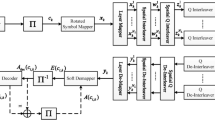Abstract
In this paper it is shown how spatial and temporal processing can be combined to increase the capacity of CDMA-based wireless communications systems. Degrees of freedom provided by space-time processing can be exploited to combat both fading and co-channel interference (the near-far effect). Specifically, we formulate and study the following methods: (1) space-time diversity, (2) cascade optimum spatial-diversity (RAKE) temporal, (3) cascade optimum spatial-optimum temporal, and (4) joint domain optimum processing. It is shown that, due to its interference cancellation capability, optimum combining provides significantly better performance than diversity processing. In particular, it is shown that in a typical CDMA scenario with two antennas, the joint domain optimum combining system provides at least a 25% increase in capacity over diversity processing. Optimum combining may be applied to compensate for imperfect power control of the signals received at the base station.
Similar content being viewed by others
References
D.D.Falconer, F.Adachi, and B.Gudmundson, “Time division multiple access methods for wireless personal communications,” IEEE Commun. Mag., Vol. 33, pp. 50–57, 1995.
R.Kohno, R.Meidan, and L.B.Milstein, “Spread spectrum access methods for wireless communications,” IEEE Commun. Mag., Vol. 33, pp. 58–67, 1995.
K.S.Gilhousen, I.M.Jocobs, R.Padovani, and L.A.WeaverJr., “Increased capacity using CDMA for mobile satellite communication,” IEEE J. Selected Areas in Commun., Vol. 8, pp. 503–513, 1990.
D.J.Goodman, “Trends in cellular and cordless communications,” IEEE Commun. Mag., Vol. 29, pp. 31–40, 1991.
W.C.Lee, “Overview of cellular CDMA,” IEEE Trans. Vehic. Technol., Vol. 40, pp. 291–302, 1991.
P.Jung, P.W.Baier, and A.Steli, “Advantages of CDMA and spread spectrum techniques over FDMA and TDMA in cellular mobile radio applications,” IEEE Trans. Vehic. Technol., Vol. 42, pp. 357–364, 1993.
B.R.Vojcic, R.L.Pickholtz, and L.B.Milstein, “Performance of DS-CDMA with imperfect power control operating over a low earth orbiting satellite link,” IEEE J. Selected Areas in Commun., Vol. 12, pp. 560–567, 1994.
Y.-S.Yeh and D.O.Reudink, “Efficient spectrum utilization for mobile radio systems using space diversity,” IEEE Trans. Commun., Vol. 30, pp. 447–455, 1982.
S.C.Swales, M.A.Beach, D.J.Edwards, and J.P.McGeehan, “The performance enhancement of multibeam adpative base-station antennas for cellular land mobile radio systems,” IEEE Trans. Vehic. Technol., Vol. 39, pp. 56–67, 1990.
J.C. Liberti and T.S. Rappaport, “Reverse channel performance improvements in CDMA cellular communication systems employing adpative antennas,” in Proceedings of the IEEE GLOBECOM, Houston, TX, pp. 42–47, 1993.
J.H.Winters, “Optimum combining in digital mobile radio with cochannel interference,” IEEE Trans. Vehic. Technol., Vol. 33, pp. 144–155, 1984.
J.H.Winters, “On the capacity of radio communication systems with diversity in a Rayleigh fading environmen,” IEEE J. Selected Areas in Commun., Vol. 5, pp. 871–878, 1987.
J.H.Winters, “Signal acquisition and tracking with adaptive arrays in the digital mobile radio systems IS-54 with flat fading,” IEEE Trans. Vehic. Technol., Vol. 42, pp. 377–384, 1993.
J.H.Winters, J.Salz, and R.D.Gitlin, “The impact of antenna diversity on the capacity of wireless communi systems,” IEEE Trans. Commun., Vol. 42, pp. 1740–1751, 1994.
X. Wu and A. Haimovich, “A simple projection based adaptive array with applications to mobile communications,” in Proceedings of the 1994 Adaptive Antenna Systems Symposium, Melville, NY, pp. 37–42, 1994.
R.Kohno, H.Imai, M.Hatori, and S.Pasupathy, “Combination of an adaptive array antenna and a canceller of interference for direct-sequence spread-spectrum multiple-access system,” IEEE J. Selected Areas in Commun., Vol. 8, pp. 675–681, 1990.
R. Kohno, “Spatial and temporal filtering for co-channel interference in CDMA,” in Proceedings of the IEEE Third International Symposium on Spread Spectrum Techniques & Applications (ISSSTA'94), Oulu, Finland, pp. 51–60, 1994.
N. Ishii and R. Kohno, “Spatial and temporal equalization based on an adaptive tapped-delay-line array antenna,” in Proceedings of the 1994 IEEE Personal Indoor and Mobile Radio Communications (PIMRC), The Hague, Netherlands, pp. 232–236, 1994.
A.F. Naguib and A. Paulraj, “Performance of CDMA cellular networks with base-station antenna arrays,” in Mobile Communications: Advanced Systems and Components, 1994 International Zurich Seminar on Digital Communications Proceedings, Zurich, Switzerland, pp. 87–100, 1994.
B.H. Khalaj, A. Paulraj, and T. Kailath, “Spatio-temporal channel estimation techniques for multiple access spread spectrum systems with antenna arrays,” in Proceedings of the IEEE International Conference on Communications (ICC), Seattle, WA, pp. 1520–1524, 1995.
J.G.Proakis, Digital Communications, McGraw-Hill, New York, NY, 1989.
K.S.Gilhousen, I.M.Jocobs, R.Padovani, A.J.Viterbi, L.A.WeaverJr., and C.E.Wheatley, “On the capacity of a cellular CDMA system,” IEEE Trans. Vehic. Technol., Vol. 40, pp. 303–312, 1991.
Author information
Authors and Affiliations
Rights and permissions
About this article
Cite this article
Bernstein, X., Haimovich, A.M. Space-time optimum combining for CDMA communications. Wireless Personal Communications 3, 73–89 (1996). https://doi.org/10.1007/BF00333924
Issue Date:
DOI: https://doi.org/10.1007/BF00333924




